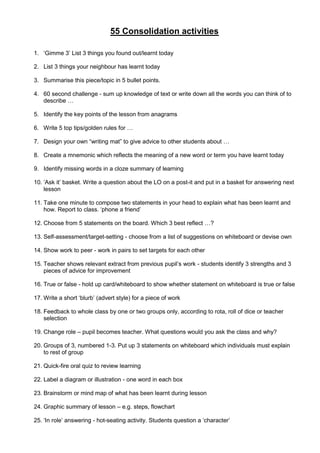
55 consolidation ideas
- 1. 55 Consolidation activities 1. „Gimme 3‟ List 3 things you found out/learnt today 2. List 3 things your neighbour has learnt today 3. Summarise this piece/topic in 5 bullet points. 4. 60 second challenge - sum up knowledge of text or write down all the words you can think of to describe … 5. Identify the key points of the lesson from anagrams 6. Write 5 top tips/golden rules for … 7. Design your own “writing mat” to give advice to other students about … 8. Create a mnemonic which reflects the meaning of a new word or term you have learnt today 9. Identify missing words in a cloze summary of learning 10. „Ask it‟ basket. Write a question about the LO on a post-it and put in a basket for answering next lesson 11. Take one minute to compose two statements in your head to explain what has been learnt and how. Report to class. „phone a friend‟ 12. Choose from 5 statements on the board. Which 3 best reflect …? 13. Self-assessment/target-setting - choose from a list of suggestions on whiteboard or devise own 14. Show work to peer - work in pairs to set targets for each other 15. Teacher shows relevant extract from previous pupil‟s work - students identify 3 strengths and 3 pieces of advice for improvement 16. True or false - hold up card/whiteboard to show whether statement on whiteboard is true or false 17. Write a short „blurb‟ (advert style) for a piece of work 18. Feedback to whole class by one or two groups only, according to rota, roll of dice or teacher selection 19. Change role – pupil becomes teacher. What questions would you ask the class and why? 20. Groups of 3, numbered 1-3. Put up 3 statements on whiteboard which individuals must explain to rest of group 21. Quick-fire oral quiz to review learning 22. Label a diagram or illustration - one word in each box 23. Brainstorm or mind map of what has been learnt during lesson 24. Graphic summary of lesson – e.g. steps, flowchart 25. „In role‟ answering - hot-seating activity. Students question a „character‟
- 2. 26. In pairs, answer the question set at the start on a post-it note. Stick on board and review 27. Where can you apply this skill/knowledge in your H/wk or other subjects? Give 3 examples 28. Who/what am I? Single question like „What‟s my line?‟ 29. Prediction. What will happen next? Justify your point of view. 30. „Feelings Silhouette‟. Draw a person wearing a hat and carrying a toolbox. Annotate what has been learnt near the hat, write skills and ideas near the toolbox. Draw a heart on the person and write down the feelings about the topic and a rubbish bin to show what did not work or wasn‟t understood in the lesson 31. Continuum. Students stand in a line according to how they feel about a topic. Can also be used to explore statements and opinions. 32. Traffic Lights. Students use Red, orange and green cards to indicate their level of understanding on a topic 33. Toss the bean-bag/ball. Students ask questions of each other based on learning. 34. „Splat‟ Put up key words on whiteboard. 2 students as „splatters‟. Class question the 2 at the front. Students answer‟ by „splatting‟ the correct word on the board. Winner stays up, questioner replaces loser. 35. Loop. Students answer questions on 2-sided cards. Green side: Question. Red side: Answer to another question. Teacher starts and activity goes on until all questions have been asked and answered, ending with the teacher‟s answer 36. Dominoes. Statements that connect together e.g. Calcium He Helium Na Sodium K 37. Answer teacher or student questions without saying yes or no. 38. Bingo. 4x4 grid 39. Newspaper headlines. Challenge small groups to invent a newspaper headline about the topic studied. Present like newspaper sellers!! 40. Football commentary or match report. Give students reminders about a topic over a few lessons. On a subsequent lesson ask them to feed back in the style of a football commentator (a la John Motson) They could record these and play back to class 41. Diamond ranking. Set question. Students have 9 ideas to prioritise. Ideas on post-it notes and arrange in diamond shape of importance 42. Verbal football. Students/teacher use previously devised questions. Split class in half and sit facing each other. 3 questions in a row correct scores a „goal‟ If fail, other team still have to get „three in a row‟ Team with most „goals‟ wins. 43. Pictionary. Students work in teams on whiteboard to draw knowledge/skills/facts etc. 2 mins max 44. Pictures/cartoons – which would you put with today‟s learning and why? 45. Exit jeopardy. Give the answers to key points from the lesson. Students have to raise their hands to give the question. If correct, they get to leave.
- 3. 46. Odd one out. Pictures or words put on whiteboard for students to compare and contrast 47. Freeze frame summary. Students take up a pose that would represent a concept, fact or subject. Rest of class have to guess what they are representing 48. „Who wants to be a millionaire?‟ Students set question with 4 possible answers on learning 49. Blockbusters. ICT interactive game 50. Stand - up/sit – down. Q&A which forces students to stand-up/sit-down according to whether they agree/disagree, true/false, higher/lower etc 51. In 1 minute, draw what you‟ve learnt today. Partner has 20 secs to guess. 52. Use „text – speak‟ to review learning on a post-it 53. Post-it „you‟re out of order. Sequencing activity 54. Elimination. Put up a list of numbers/facts etc on whiteboard. Give clues to eliminate to leave one answer 55. Smiley/sad faces. Reflect on part of the learning and discuss positive/negative aspects. Draw chart and respond with appropriate „faces‟ and points for improvement